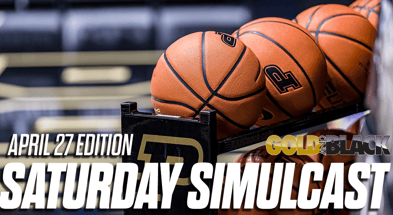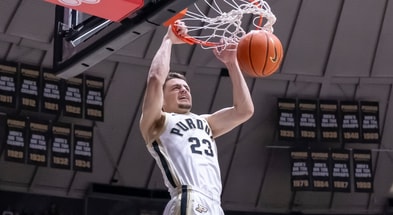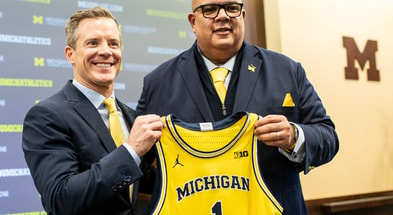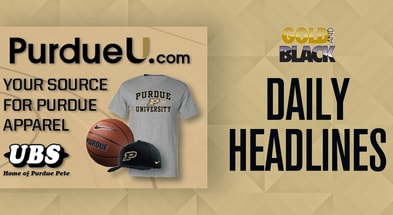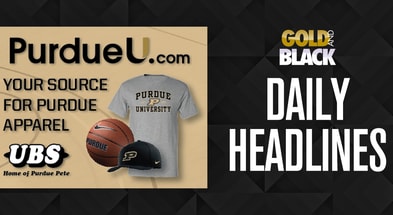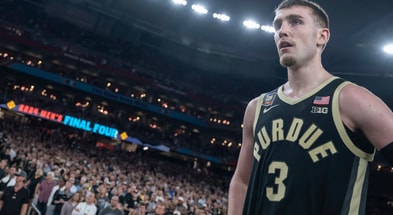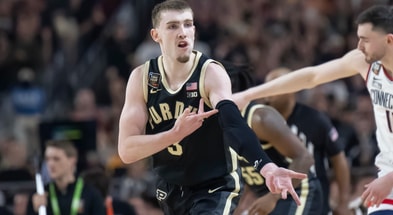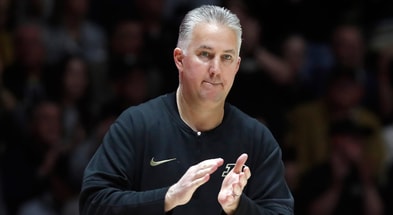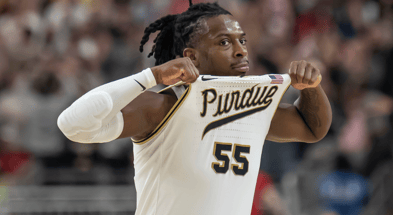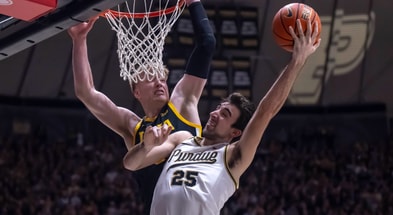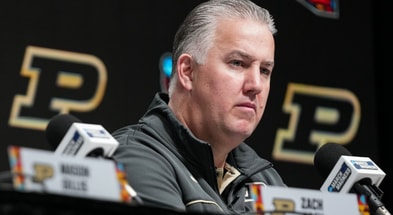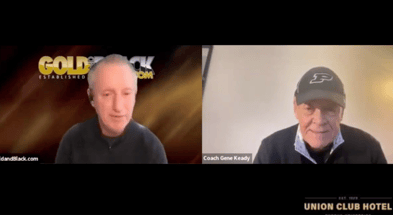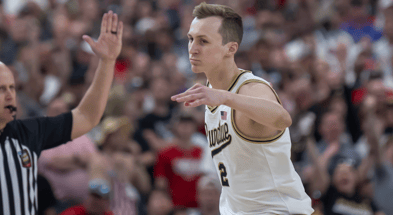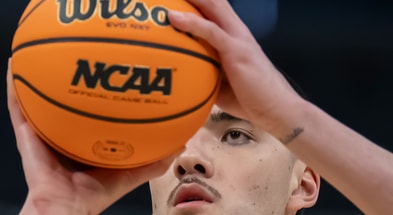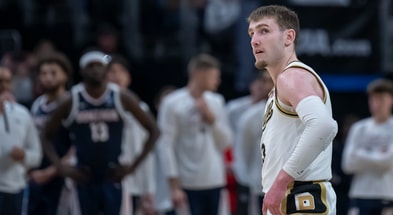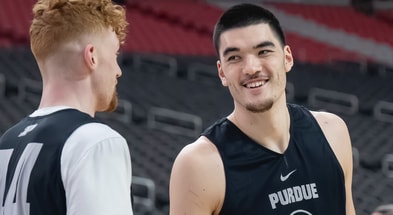Keady-Painter Line: The Purdue Basketball Track, Pure Gold
This essay was submitted by former Purdue men’s basketball point guard Carson Cunningham (1998-2001)
“Death. Taxes. Painter.” It’s a catchy saying CBS’s Jon Rothstein uses to highlight the gold-like durability of the Purdue men’s basketball program, a program that for darn near half a century has been led by two men, Lloyd Eugene Keady and essentially his basketball son, Matthew Curtis Painter. Put another way, a program that, since Jimmy Carter was president, has broken the huddle with the same mantra: “Together, We Attack.”

Rothstein’s saying hints at ideas that power this durability. These ideas reside deep in the seams of the Boilermaker community and long predate basketball itself. These ideas are as enduring as life and death and taxes. Taken together, they have turned Purdue Basketball into a transcendent cultural force in Indiana, the basketball state of all basketball states.
To understand it, three crucial elements need to be considered: Purdue’s community, its leadership, and its players. These provide a map of the golden tracks that make up the Keady-Painter Line.
Purdue’s People
Trying to capture the Purdue community’s affection for basketball takes you way back, to before peach baskets got hung and before the Monon Line, the railroad that ran through town and from which the Boilermaker name arose. At a fundamental level, to use basketball parlance, it takes you to founding American ideals, including that of melding the primacy of the individual with the potential beauty of the group “in order to form a more perfect union.” Individual stars drive the engine. However, “Together, We Attack.”
Other attendant things figure prominently in understanding the Boilermaker community, including an appreciation for the power of work, the value of innovation, and the reality of competition. We aren’t the fanciest of people. The elites, thankfully, attest to that for us. Marquis de Lafayette, for whom Purdue’s hometown of West Lafayette is named, described matters well. In 1777, he wrote from America to his wife in Europe about a people whose work he admired and who had a “simplicity of manners, the desire to oblige, the love of country and liberty.” If he were writing in the future and from the namesake Indiana town that Purdue calls home, he would’ve added: “And they love basketball.”
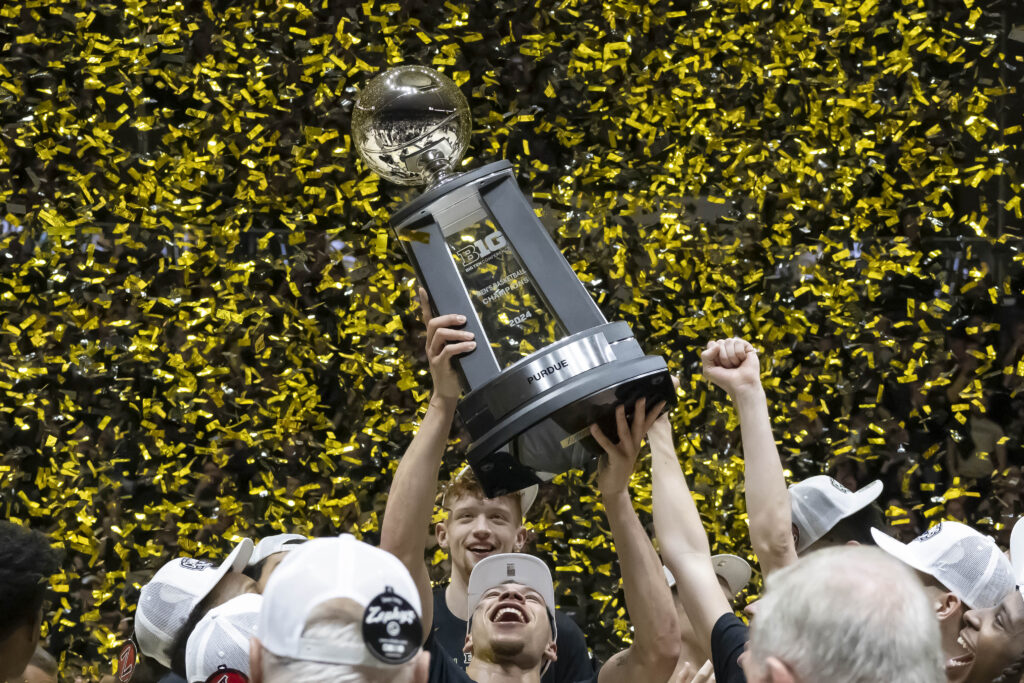
In early March late this season, after a home win over Wisconsin, Purdue fans at a sold-out Mackey Arena stayed en masse well after the game to watch Senior Night festivities. Social media commentators marveled: How does a stadium of such capacity stay filled a near-hour after the game? This summer, about 8,000 fans came out to the Boilermakers’ alumni game—yes, an alumni game. Since 2019, every Purdue home game has sold out.
Purdue fans don’t just go to the games. They measure time by their team in a metric that aligns with farm life over thousands of years. Basketball was, after all, woven into the rhythms of seasonal farm life from the time it was created by Canadian Dr. James Naismith. And farming remains a crucial part of Indiana life. Yet in modern times, fewer have actual crops with which to measure seasons. We do have basketball, though.
Summer is a time for players to grow their games. Coaches tend to them while working on bringing in new seedlings. Autumn’s chill signals that it’s time to bring the full harvest to campus, to blend the new with the old, like adding yeast to fresh dough. Gotta knead it a little. Just ask my old coach, Gene Keady.
Winter comes, and everyone is eager to observe the yeast do its work, watch the product rise, and see what we have. We even take it around to test heartiness and see what others might have. Sure, Jack Frost will present inevitable challenges, especially on the road. It’s all part of the journey. By and by we sense spring a-coming. The new generation might say that this signals it’s time to eat. Us older folks know what they mean: it’s time to dance.
And this brings us to the elephant on the farm: the NCAA tournament. In his oft-cited Frontier Thesis, the late historian Frederick Jackson Turner spoke of America’s “restless, nervous energy.” For Purdue fans that’s exactly the kind of energy that accompanies the coming of the Big Dance. Oh, we’re gonna go. But on the floor, will we be able to shake it off?
Purdue’s Leaders
Such people deserve steadfast leadership. Purdue Basketball has delivered, to the tune of 11 Big Ten titles across the Keady-Painter Line, and a matching eleven Sweet Sixteens. Most general college basketball fans know about Purdue Basketball’s penchant for lunch buckets, that the Boilers exude toughness, power, and practicality. Many know of its embrace of man-to-man defense, its appreciation for offensive movement, and its ability to develop freshmen rather than rely on the portal. Less talked about is Purdue’s adaptability. Take ball screen coverage. It used to mostly hedge. Now it ices, drops, switches, and hedges. Consider offense. Off-ball action used to lead the way. But there’s a whole lot of ballscreen play propelling the action now, staggered, flipped, inverted, you name it. The line evolves.
It takes foresight, stewardship, and artfulness to deliver this sort of leadership. It also takes slices of humble pie. All of these things featured in the engineering–we are talking about Purdue after all–of a crucial bridge, designed by then Purdue Athletic Director Morgan Burke, that led to the incredible continuity of the Keady-Painter Line. This bridge smoothly transferred power while keeping the program’s defining parts rolling. Power transfer is no small feat–look at today’s political climate. Not getting it right can come at a hefty, long-lasting price. See: post-Knight Hoosiers, Indiana University. Benjamin Franklin acknowledged the perils when he wrote, ” A republic if you can keep it.” AD Burke, Keady, and Painter found a way to keep it.
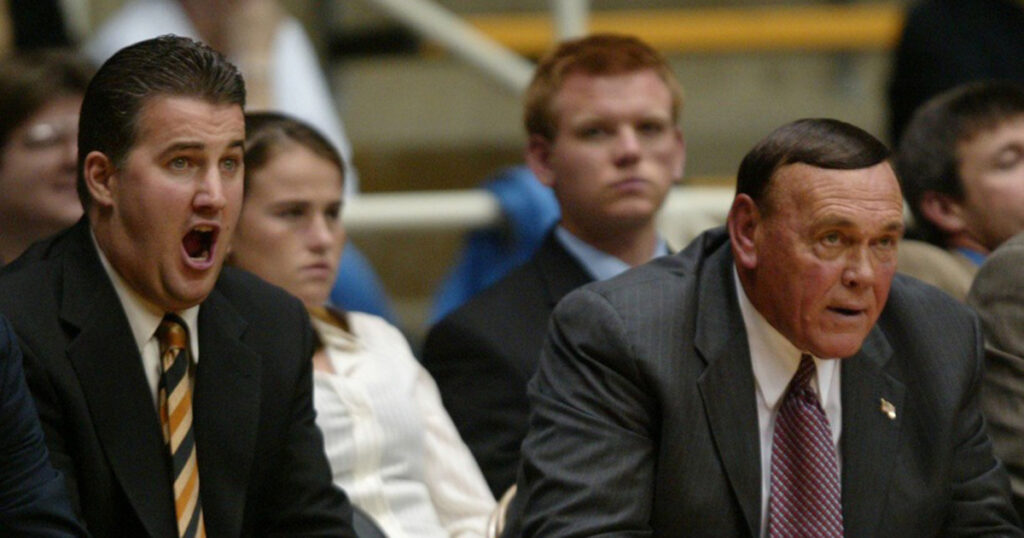
This bridge, in fact, is perhaps the most overlooked part, nationally, of Purdue Basketball’s current story. Die-hards remember it. It’s April 2004, Purdue has lost five straight to end the season, and Gene Keady, a six-time National Coach of the Year and sure-fire Hall-of-Famer looks to be at the end of a great ride. Well, at least the late AD Burke saw it that way. Coach Keady wanted a long-term deal and flirted with potential suitors. Complicating matters, Keady and Burke, while they respected each other and loved Purdue, weren’t exactly poker buddies hanging in the same railcar.
When it came to a coach, Burke could’ve chosen a completely new route. Yet he was astute and considerate enough to know the importance of finding a way forward with the competitive, hard-working spirit with which Keady had imbued the program intact, and he wanted to connect the next coach with Keady. A natural choice, however, was long-time Keady assistant Bruce Weber, who was working wonders at Illinois and was no longer an option. To outsiders, Burke needed to pull an inside straight to keep matters on track. As for Keady, he could’ve upended the table, raised hell, and tried to get backers to throw out Burke. Yet he was astute and considerate enough to realize this wasn’t the way forward. Their love of Purdue served as a guide.
Enter Painter. He had played under Keady at Purdue in the early nineties, worked as an assistant under Weber at Southern Illinois, and just went 25-5 as the Salukis head coach. A move up to a bigger league seemed inevitable. But he was just in his early thirties. Only a single power conference head coach was younger than him. Where others might’ve balked, Burke, believing in Painter’s bright future as a skipper and drawing on his corporate background, decided to sell a succession plan: bring in Painter for a season as heir apparent, let Coach Keady take a final lap, and give way. Would Keady go along? Would Painter–rather than remain a head coach and see who else comes calling?
As Bill Raftery might say, it took “onions” to get everyone on board–as well as humility, that humble pie. Now we see the fruits. Purdue enters March Madness as a No. 1 seed again, approach and values intact, community firmly behind ’em. We know getting to the Final Four will take an extra serving of onions. Shoot, going by the recent past, for this year’s dance we’re gonna need to bring the whole cornucopia. If we are able to, it’ll sustain us all the way to Arizona.
Purdue’s Players
In the end, the players will conduct the length of the dance. As they should. And, my, what a crew: craftsmen, gliders, hammerers, speedsters, humdingers. Ballers. Boilermakers have delivered more Big Ten men’s basketball titles than any other university, and they sport an all-time-winning record versus every other Big Ten team.
About that elephant…there’s been some close calls, some tough breaks, and some snags. The 1988 team, powered by the magical trio of Mitchell, Stephens, Lewis lost a one possession battle with Kansas State. There’s the back injury that Glenn “Big Dog” Robinson, the National Player of the Year and soon-to-be number-one NBA draft pick, took into Purdue’s 1994 Elite Eight showdown with Duke shortly after he posterized Kansas in a dominant Sweet Sixteen win. The late-February, 2010 Robbie Hummel ACL injury, on a day that Purdue beat Minnesota to go 24-3, was a tough blow. That squad finished 29-6 and bowed out in the Sweet Sixteen to Duke without its All-American Hummel. There’s the 2018 “hook-and-hold.” The heartbreaking 2019 Elite Eight OT loss to Virginia is still hard to talk about.
Oh, and there’s the 2000 Elite Eight loss to Wisconsin by four. I got to play in that tourney run. Ah, to look back and think of my fellow riders: Cornell, Cardinal, the whole bunch.
My road roommate that season was Greg McQuay. We understood each other. We were both from The Region, had played against each other in middle school, then at rival high schools–he and his brother Gary at West Side, me at Andrean. Eventually, all three of us would suit up together as Boilermakers.
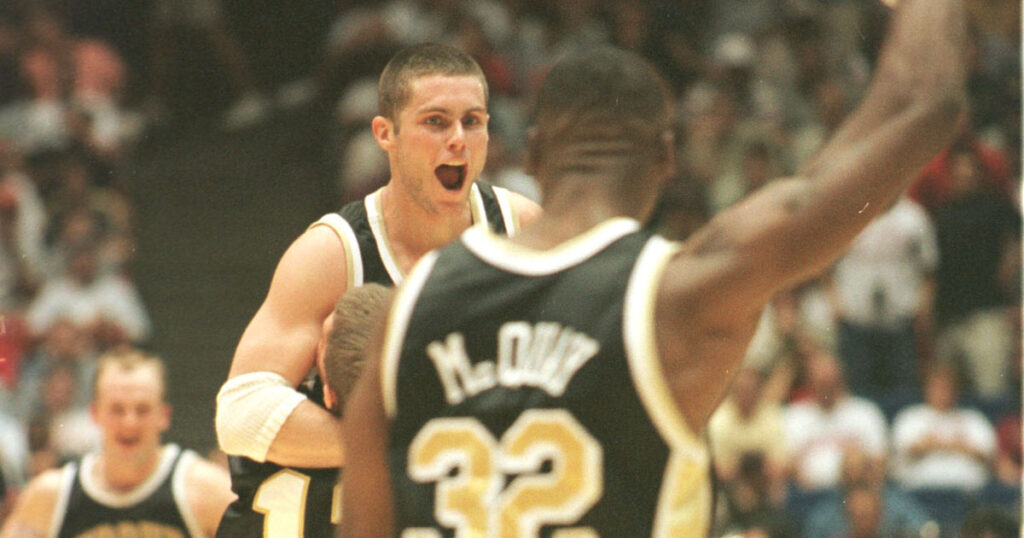
Greg, the quieter of the McQuay brothers, had an uncanny knack for painting. Gary, more outgoing, had a charismatic spark. They were so close, they might as well have been twins. And their rise was something to behold, literal and figurative. They didn’t have much growing up. When they brushed their teeth in the morning, they had to use the kitchen sink. The bathroom didn’t have one. But the McQuay brothers had pluck, and hops, enough to jump a track, to help ’em soar to the Big Ten.
By the time of our 2000 Elite Eight run Gary was back home, stricken with cancer. Greg and I and the rest of the crew were in Tucson. We had a showdown with three-seed Oklahoma to get to the Sweet Sixteen. Night before, I remember waking up at about 2:00 a.m. and seeing Greg quietly working on a painting. He said he had a project due. Around 5:00 a.m. I rolled awake again and saw that he was still painting. Then it struck me. He was grieving.
Hours later Greg McQuay played like a Purdue rocket man. Carried us to victory. If you watch the game, you can spot messages on his shoes to his brother Gary. Really, that whole tournament he played like a cosmic wonder. We lost Gary two years later. His pastor brought a basketball to the funeral, asked those of us in the pews to pass it around, to feel Gary’s energy within, and to go out and keep that spark alive. That kind of thing happens at funerals in Indiana.
And the sparks are alive on the Keady-Painter Line, reflecting a level of connectivity to the past, present, and future that is unilike anything college basketball has seen before. Nowadays, Hummel covers tons of Purdue games on NBC, FOX, BTN. If not him, probably on the call is Raphael Davis, also a former Boilermaker. As for the Big Dog, his son Gicarri Harris just signed with Purdue. He’ll be coached by his dad’s former Boiler teammates, Painter and assistant Brandon Brantley, recently named the Big Ten’s Assistant Coach of the Year. Brantley and Robinson used to battle each other in high school, Andrean versus Gary Roosevelt. You gotta know the line, and its off-shoots, runs through northern Indiana.
This year’s Purdue team alone has on its roster the off-spring of several former Boilermakers. Dave Barrett’s son Carson; Matt Waddell’s son Brian; Coach Cuonzo Martin’s son Chase. Look closer, and you will see Carson Vrabel, a freshman Purdue hoops manager. His dad, Kevin, was a manager in the nineties. Oh, and current junior Caleb Furst‘s brother Josh joined the squad this year. Can you think of a better compliment for Keady-Painter?
This year’s team features a nod to basketball’s history, too, as its lead operator is two-time National Player of the Year Zach Edey, fittingly a Canadian, given Dr. Naismith’s connection to our state’s game. The line goes on and on.
Purdue’s True Impact
This startling connectivity to past, present, and future illuminates Purdue Basketball’s true impact. Abraham Lincoln, who was long and lanky and raised in Indiana from the ages of five to twenty-one–gotta bet he’d’ve hooped if brung up today–once said, “Time is a great thickener of things.” Over the long run, ways of life get imprinted deep within our bones. Purdue Basketball is thickening these things for the people of Indiana. We cherish this. We are grateful for it.
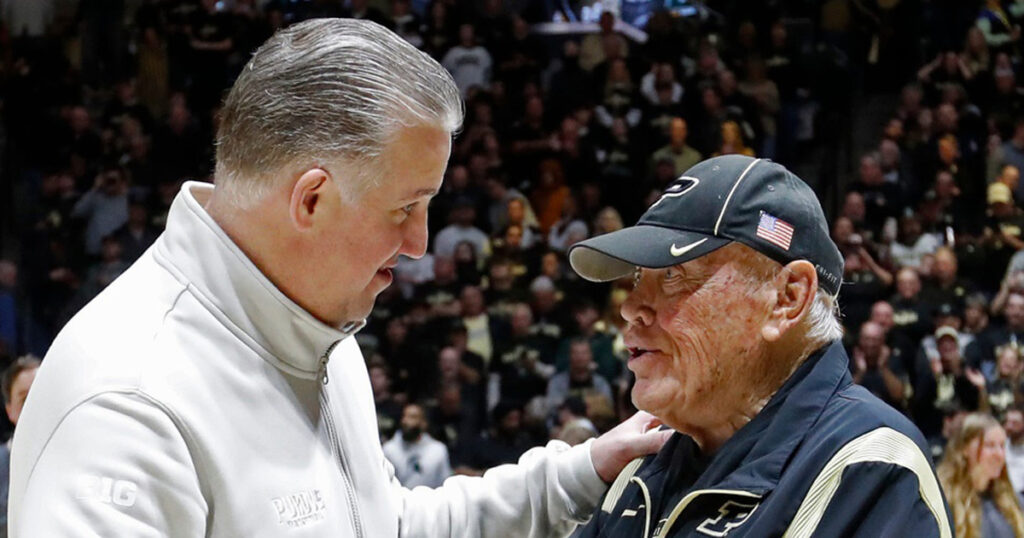
The recent picture of Gene Keady and Matt Painter embracing on Keady Court, in Mackey Arena, along John Wooden Drive, after yet another Big Ten championship embodies so much. So, too, does Coach Keady’s recent move back to West Lafayette. He’d retired to Myrtle Beach, South Carolina–good weather, grand beaches. But he’s 87 now. The sun is setting, and golden hues are visible but fainter. He wants to be where his heart is during this part of the ride. We know that the Boilermaker community will wrap him up. That’s how it rolls.
We would love to pull up to Glendale, Arizona this April to celebrate. But even if we don’t get that party, we have thicker, more enduring things to sustain us. Because no matter what happens, another season will come. And deep down, we know how we will navigate it, whatever it holds. The approach is age-old. And to us it’s pure gold.
Boiler Up, Hammer Down,
Carson Cunningham (Purdue ‘00, ‘01, ‘06)
Cunningham is an assistant men’s basketball coach at Army West Point. Before that, he spent 10 seasons as a college head coach. As a player at Purdue, he helped lead the Boilers to two Sweet Sixteens and an Elite Eight. He played professionally in the CBA and Europe. In 2006, Cunningham earned a Ph.D. in history from Purdue. He’s the author of five books. But he says his greatest work is marrying Christy Cunningham (Purdue ’01, VB) and raising their six kids together.
RELATED: WELCOME TO TROPE SEASON
